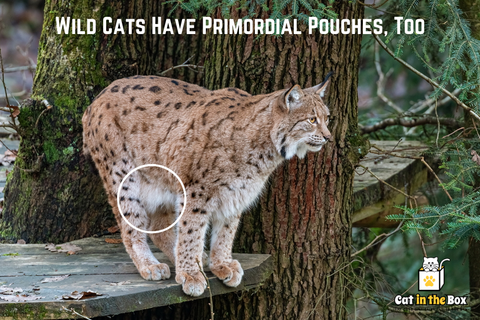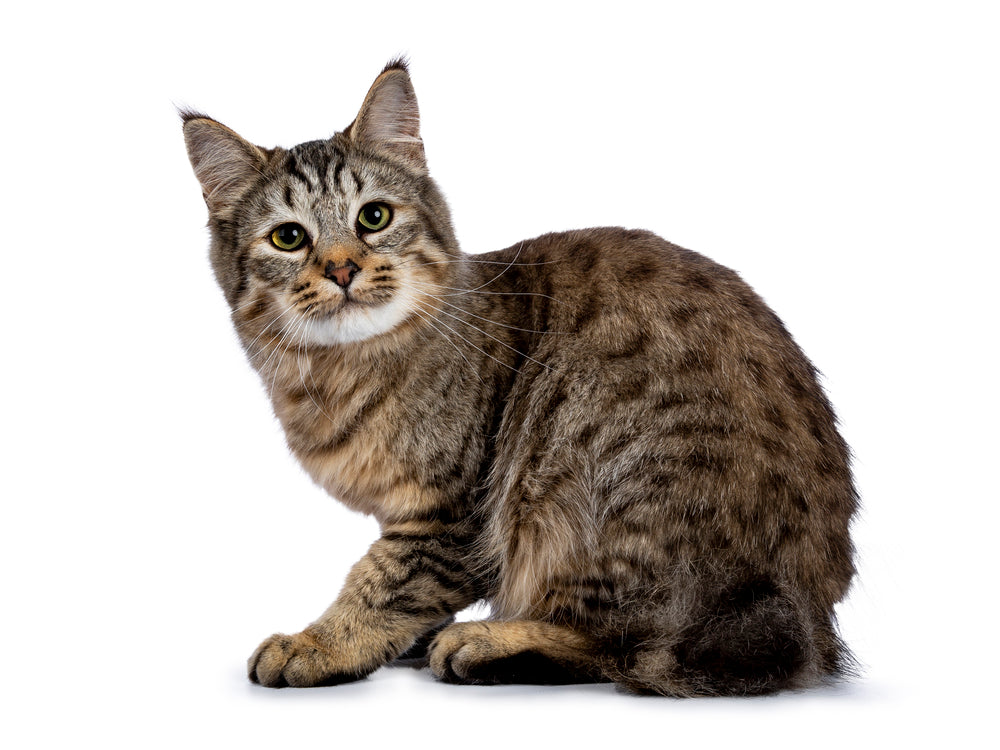What is the primordial pouch in cats?
If you’re reading this post, it’s probably because you were noticing your cat has some loose belly skin and you were wondering what it’s all about.

Maybe you worry that her stomach is hanging low because you’ve overfed her. Or perhaps you’re wondering if the loose skin is from a pregnancy that happened before she came into your life. Or maybe you’re concerned that she’s got a bit of a “pooch” from lack of exercise.
Actually, the loose-hanging belly that you’re noticing on your cat is not from any of those things, and it does have a name. It’s called a primordial pouch, and it’s a perfectly normal part of any cat’s anatomy. It does not mean your cat is fat (although he could be). It does not mean he’s not getting enough exercise (although that may still be true). And it would be there whether your cat had ever been pregnant or not, although obesity and a pregnancy can make a primordial pouch appear more pronounced.
What is a primordial pouch?

A cat’s primordial pouch is a saggy flap of (usually) fur-covered extra skin on your cat’s underside. It typically covers the length of a cat’s stomach but is most noticeable toward a cat’s hind legs. The pouch may sway left and right with every step, or it may jiggle a bit as she walks.
Note that the primordial pouch is moveable and elastic. It’s not attached to any underlying muscle. If your cat will let you touch him there – and he may not; please respect your cat’s personal preferences when it comes to petting – it should feel like a nearly-empty water balloon.
All felines – not just house cats – have a primordial belly, but they vary in size between species and from one individual to the next. Even big cats like lions and tigers will sport a primordial belly.
Here’s a photo of a lynx. You can see a bit of saggy belly on this obviously fit and healthy wild cat.

Why is it called a “primordial pouch”?
Primordial can mean a few different things. Its primary meaning is “from the beginning of time.” It comes from the Latin word for “origin.”[1]

It’s true that cats have probably always had this body part. Here’s a picture of an ancient Egyptian statue of a cat, and as slender as this rendering of a cat is, the saggy double pouches on the belly are clear. This statue is many thousands of years old, but “beginning of time” seems a bit…extravagant for a term that describes some excess skin.
Perhaps the namers of the pouch were thinking of the second definition of “primordial,” which is “basic,” or “fundamental.” I think this is more likely, as the pouch is just basically or fundamentally a pouch. Nothing more, nothing less.
What is the purpose of a primordial pouch?
Unfortunately, science does not seem to have an explanation for the existence of the primordial pouch. There are plenty of armchair scientists’ theories out there, however, that may or may not have merit. Let’s look at those.
Does the primordial pouch protect a cat’s organs in a fight?
 he primordial pouch reminds me of the extra skin on the Chinese Shar-Pei, a dog with many wrinkles, bred for fighting. The loose folds of skin on the dog’s face and body were designed to prevent a bite from another dog from going too deep, and to allow a dog under attack some flexibility to turn around and bite back.[2]
he primordial pouch reminds me of the extra skin on the Chinese Shar-Pei, a dog with many wrinkles, bred for fighting. The loose folds of skin on the dog’s face and body were designed to prevent a bite from another dog from going too deep, and to allow a dog under attack some flexibility to turn around and bite back.[2]
Does the primordial pouch allow a cat to run faster?
 A related theory is that the primordial pouch allows a cat to glide as it leaps, perhaps allowing it to soar just a tiny bit longer and further than he would without the pouch.[3] You could say that the pouch acts like the flap of skin between the legs of a flying squirrel – which are not wings so much as parachutes.[4] Extra skin does create drag, allowing animals with extra skin in strategic places to glide further than animals without. I don’t know of any aerodynamic studies performed on leaping cats, and I won’t be convinced until I do, but it’s something to think about.
A related theory is that the primordial pouch allows a cat to glide as it leaps, perhaps allowing it to soar just a tiny bit longer and further than he would without the pouch.[3] You could say that the pouch acts like the flap of skin between the legs of a flying squirrel – which are not wings so much as parachutes.[4] Extra skin does create drag, allowing animals with extra skin in strategic places to glide further than animals without. I don’t know of any aerodynamic studies performed on leaping cats, and I won’t be convinced until I do, but it’s something to think about.Does a primordial belly allow a cat to store extra food?
 Second, many hunting animals gorge, but don’t have primordial bellies. A wolf, for example, can go for two weeks without eating and then consume a quarter of his weight in meat in a single sitting.[5] And wolves don’t have primordial pouches.
Second, many hunting animals gorge, but don’t have primordial bellies. A wolf, for example, can go for two weeks without eating and then consume a quarter of his weight in meat in a single sitting.[5] And wolves don’t have primordial pouches.
Does spaying or neutering cause cats to get a primordial belly?
The primordial belly is sometimes called the “spay sway,” from the mistaken belief that spaying or neutering a cat causes this hanging tummy skin.
The association between spaying and neutering and the development of the primordial belly might be incidental. Cats seem to develop their primordial bellies as they start to mature into adulthood, at a time when many cats are coincidentally spayed and neutered.
How do I know that my cat isn’t just overweight?

You are right to be concerned about your cat’s weight. A 2018 study conducted by the Association for Pet Obesity Prevention found that nearly 60% of house cats were overweight.[6] Being even a little overweight can be a very serious problem for house cats. Please read more about obesity in cats and how to help them lose weight in this post, “How to help a cat lose weight.”
But there is a big difference between a normal and healthy primordial pouch and the excesses of an overweight cat. A primordial pouch is loose, it hangs low, and swings from side-to-side very easily. An overweight belly is firmer, rounder, and doesn’t swish when your cat walks.
You can tell if your cat is truly overweight by becoming familiar with her body. Run your hands along both sides of your cat and along her spine. You should feel ribs beneath a little layer of fat, and you should also be able to feel the vertebrae in her back under a small cushion of fat. Both are signs that your cat is a healthy weight.

And then take a look at your cat from above. There should be a little inward curve between the ribs and hips. If there is a bulge there instead of a narrowing, your cat might be overweight.
But a primordial belly is not a sign that your cat needs to lose weight.
Do certain cat breeds have primordial pouches?
In certain breeds it is standard to have a primordial pouch. In others, it’s considered “frequently observed” and an acceptable attribute for that breed at a cat show.

The Pixiebob, a house cat that looks a like a diminutive American Bobcat, is required by breed standards to have a primordial belly pouch.
Read all about the Pixiebob cat in this post.

Bengal cats commonly have a primordial pouch.[7] (Read all about the Bengal cat here)

The Egyptian Mau often has a prominent pouch. One long-time Egyptian Mau owner described a “’belly flap’ that would ‘puddle’ all around her lower legs, to the point that it formed a complete ‘skirt,’ falling all the way to the ground around her, completely hiding her back legs and toes.”[8]
Read all about the Egyptian Mau in the this post. 
Interestingly, the Japanese Bobtail, a breed often cited among those cats with prominent primordial pouches, doesn’t typically have one at all. I spoke with Greg Sorokin, a long-time breeder for Fujicats Cattery in Arizona, about the breed, and he confirmed this for me. “The Japanese Bobtail is not known to have a primordial pouch,” he said. “Websites can get this information wrong, but it’s important to consult the breed standards posted by CFA and TICA if you want to know what a certain cat breed should look like.”
Of course, any cat can have a primordial pouch. Yours doesn’t have to be a fancy breed to sport this uniquely feline feature.
If you'd like to read about another belly-related topic, read this post on why cats show you their bellies.
Love Pinterest? Here's a Pinterest-friendly pin for your boards!

Dawn LaFontaine
Dawn LaFontaine is a lifelong animal lover who always seems to have a little pet hair in her keyboard. Her blog, Kitty Contemplations, helps cat guardians better understand and care for the special beings they share their lives and homes with. Her cat-products business, Cat in the Box, sells beautiful, well-made, and award-winning products that she designed to meet the biological needs of cats.
_______________
FOOTNOTES
[1] “Primordial (Adj.).” Index, www.etymonline.com/word/primordial.
[2] “10 Wrinkly Facts About the Shar-Pei.” Mental Floss, 8 Feb. 2016, www.mentalfloss.com/article/74992/10-wrinkly-facts-about-shar-pei.
[3] “Bengal Body Shape.” Atom, www.quality-bengal-kittens.com/bengal-breeding-blog/blog/bengal-body-shape.
[4] Anonymous. “How Do Flying Squirrels Fly?” How Things Fly, 14 June 2014, howthingsfly.si.edu/ask-an-explainer/how-do-flying-squirrels-fly.
[5] Hays, Jeffrey. “WOLVES ON THE HUNT.” Facts and Details, May 2016, factsanddetails.com/asian/Northern_Asian_and_European_Animals/sub2_8a/entry-4905.html.
[6] “2018.” Association for Pet Obesity Prevention, 12 Mar. 2019, petobesityprevention.org/2018
[7] “All about the Breed.” About The Breed, bengalcatbreeder.com.au/index.php/the-breed/about-the-breed.
[8] Broad, Michael. “Egyptian Mau Belly Flap.” PoC, PoC, 11 July 2012, pictures-of-cats.org/egyptian-mau-belly-flap.html.


10 comments
I have a male blk & white rescue cat, now10 years…
Healthy and active.
However his shape is different from most cats I’ve seen!
He looks like a Halloween cat when his back is humped up ! His legs may be shorter in the front then the back legs.
Is there a breed of this type ?
Mrs. Smith – I am married almost 31 years, so I can only begin to imagine your loss. Luckily, cats make for loving company, and it warms my heart to hear how yours fill your days with joy. I hope you enjoy the ebook as much as I enjoyed researching it and writing it.
I have three lovely cats who I love very much. I am .in my eighties and lost my husband three years ago and my cats and I spend most of our time happily together in our home. I do not know what I would do without them. They do enjoy uncatllike activities which they enjoy sharing with me. I look forward to downloading the free book so that I will better understand what and why they act. Thank you